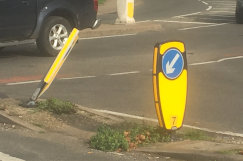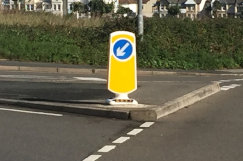In the latest in a series of articles from the Association for Road Traffic Safety and Management (ARTSM), Peter Diamond (pictured), chairman of Pudsey Diamond Engineering and chair of an ARTSM working group, discusses the evolution of the bollard.
As motor vehicles became more popular between the wars, segregation of traffic flows in towns, cities, trunk roads, and their junctions became necessary to prevent drivers of private vehicles, buses and lorries migrating from the established left lane driving. Driving on the left had originated from the leading of a horse with the right hand!

In 1935, a driving competency test was introduced to mitigate the rising incidents from drivers reverting to free spirit driving, occasionally cutting corners on either two wheels or four.
The pavements were in many cases non-existent. Kerbs and drainage were developing with carriageway design improvements. The pedestrian crossing, the roundabout and other traffic segregation systems were to come later driven by the alarming injury statistics particularly among children and cyclists who shared the carriageway with the increasingly popular motor car.
The first bollards were often boulders, rocks, wooden or cast iron posts, on the verge to prevent the vehicles from moving off the metaled surface to the soft undulating surfaces at the edges of the road.
The explosive volume of vehicles registered for road use in the post-war years has meant an almost constant review of the segregation of road users. With its densely populated geography, each decade the UK is challenged with having to adapt it's traffic separation technologies to suit the new world of developing vehicle technology.
The transition from boulder or post with the words' keep left' written on them to a fully interactive driverless vehicle interface is within reach and could only be limited by a pedestrian's or a driver's understanding of whether the third party can recognise their presence and what their likely corresponding actions might be.
Cast iron bollard frames with glass prism reflectors inset within 'keep left' wording, progressed to illuminated and legislated directional sign traffic signs within sheet steel shells.
These, in turn, gave way to base lit trans-illuminated rotationally moulded box type bollards that were initially frangible and latterly deformable in response to impact.
Illuminated panels with appropriate signage were key to visibility at night where the roads were suitably illuminated. Though curiously bollards did not have to be illuminated when the need was greatest when there was no street lighting.
The current library of bollard products available to a traffic engineer is varied and can be confusing to most. An innovation that gained in popularity around the time of the millennium was the advent of the retroreflective self-righting bollard (RSRB).
This development was being influenced by the preceding advances in retroreflective materials as found on most traffic signs. The prime requirement for traffic signs is that they should be visible and readable both from a distance and at speed, particularly when picked out by the approach of vehicle headlights.
The micro prismatic capture and bounce back of light from vehicle lights back to the eye of the driver via the sign face are fundamental to the operation of the modern signs. It is therefore not surprising that the technology should migrate from the road sign to the bollard.

The challenges of the retroreflection in relation to the position of the driver in the vehicle are relevant here.
The entrance and exit angle of light impacting the sign face material is about two degrees. Due to the integrated prismatic structure of the material, the reflection can work over a range of about + or- 15 degrees.
A number of manufacturers make materials with slightly different performance, but they are all generically similar, as the production processes and the standards typically lead manufacturers to solve the same challenges with very similar solutions.
The challenge with a two-degree entrance and exit for light transmission and return is that the drivers of many commercial vehicles can typically sit more than two metres away and above their downward optimised headlights. This means that when they approach a hazard, like for instance a roundabout or a pedestrian shielding island, they may see an intense reflection from 200 metres away as they approach, but if they are examining a complimentary sign, such as navigation or directional sign on a roundabout they may drive beyond the narrow reflective window of the RSRB.
The reading of a sign may take two seconds, during which the vehicle will have travelled 25 metres at circa 30 miles per hour and out of the illumination zone as they get closer to the navigational object. In that time they may miss an important complementary instruction or worse still a person or child who is alongside. Clearly, the faster the approach the proportionally, more distance is travelled.
Recent improvements of LED headlights with corresponding reflector improvements have reduced the amount of stray light. This may result in the reflection of the sign or bollard to the driver occurring later and so may lead to more stories to the constabulary of 'well it leapt out in front of me officer' when the intense reflection is then seen.
Modern retroreflective self-righting bollard design tends to follow one of two methodologies. The first is a deformable shaped bollard where the body is rotationally moulded using a polymer with a 'memory'.
This means that when it is impacted, the polymer shape deforms and collapses as a vehicle passes over the unit in the same way any plastic might deform when impacted. Once the vehicle has passed, then the bollard returns to its original form. These units can, if required, be illuminated from within the sign or from a conventional base lit system.
The second method, a knuckle joint bollard, has had more than one iteration. One version was developed in the United States using a pair of flexible cables tensioned against a spring mechanism to give a universal joint with limited rotational movement. A similar version was developed in Australia using a flexible polymer joint. Both systems sold very well and are still available today.

These have now been surpassed by dense polymer springback knuckle type joints attached to a more rigid lozenge blade type bollard.
The standards that retroreflective bollards are designed to are BS 8442 and BS EN 12899. These refer us to the international passive safety standard BS EN 12767 of which many readers will be familiar. In simple terms, the standard is designed to measure the deceleration of a car on impacting an installed piece of street furniture while the impacted structure deformed.
However, in the case of bollards impacted at the speeds of 50kph up to 100kph, this impact on a passenger is barely measurable. The tests take place on an open carriageway with the road clearance as per the design of the car.
Unfortunately, very few bollards are in fact set in the open carriageway. Most will be set up onto islands, which can give very different results when a vehicle impacts the installation.
One particular difficulty can be when the vehicle straddles the island so that the sump of the engine acts as a shearing surface and consequently the bollard may become detached. This can be exacerbated as the front of the car typically compresses downwards under hard braking.
The other enemy of the modern bollard is the scrubbing action of the multiple rear wheels of an articulated vehicle when turning sharply over a bollard installation. The resultant actions may obliterate a costly and highly relevant strategic road installation in seconds.
Solar-powered bollards are an additional tool in the traffic engineers armoury of products. These are not fit and forget solutions like the retroreflective models, and careful selection is needed as they may not be as robust in their capabilities as their specifications might suggest. Serviceability is an important factor for both the engineer and the suppliers in this field. Some products have the ability to be warranted for up to five years.
But is the future for bollards, as with traffic signs, in jeopardy?
Autonomous vehicle deployment is inevitably going to gain in popularity. The consequent improvement in pedestrian and animal detection is part and parcel of this technology, and so maybe the bollard has had its day. If the driving system navigates the protected obstacle, then is there really any need for a bollard?
The confidence and the experience of the adult pedestrian who wishes to navigate safely across the carriageway is second nature, but when the child who is obscured behind the lighting column base or other piece of street furniture steps out into the road in front a vehicle at literally no notice, then an autonomous system fails. Perhaps the jaywalking regulations of the USA may become necessary here on this side of the Atlantic.
The positioning of the bollard in the middle of the road may, however, be its saviour though. Much has been said, during this recent coronavirus crisis, about air quality. Where better to measure air quality than in the middle of the road? Road surface temperature can be recorded for gritting purposes.
Other possibilities for extending the use of the bollard exist; traffic counting with interactive signage could divert traffic to a secondary lane, or even close the lane while the traffic density reduces.
Modular microphones, loudspeakers and cameras could be integrated as either permanent or temporary inclusions. Radar reflection from the bollard structure by internal radar signal enhancement could be used to assist the other driving technologies.
Whatever the advances, if we knew the answers before others, we would be millionaires. The challenge with all technologies is twofold. Cost and robustness are key, but with the many advances in smart technologies all around us, the sustainability and advances of the surrounding technologies need to stabilise to allow for a considered approach.




